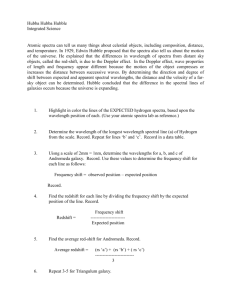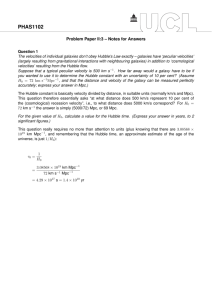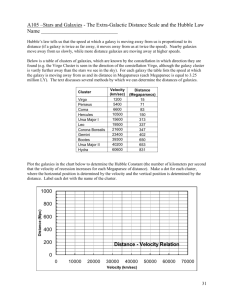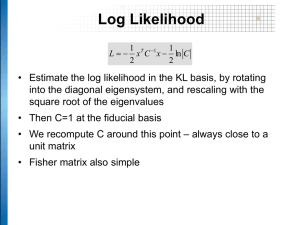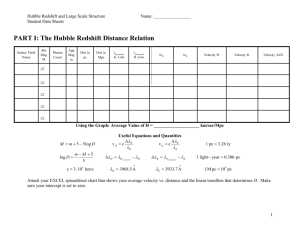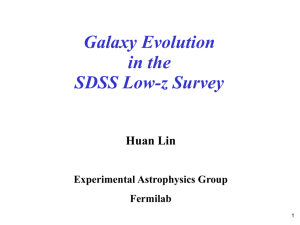Cosmological redshift
advertisement
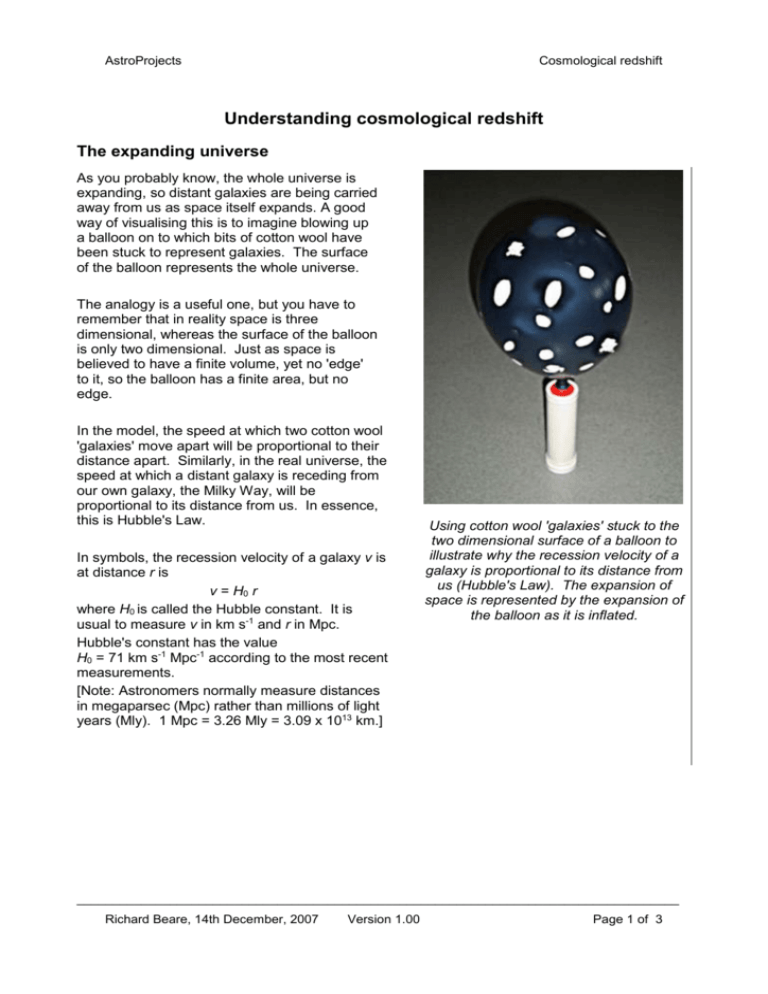
AstroProjects Cosmological redshift Understanding cosmological redshift The expanding universe As you probably know, the whole universe is expanding, so distant galaxies are being carried away from us as space itself expands. A good way of visualising this is to imagine blowing up a balloon on to which bits of cotton wool have been stuck to represent galaxies. The surface of the balloon represents the whole universe. The analogy is a useful one, but you have to remember that in reality space is three dimensional, whereas the surface of the balloon is only two dimensional. Just as space is believed to have a finite volume, yet no 'edge' to it, so the balloon has a finite area, but no edge. In the model, the speed at which two cotton wool 'galaxies' move apart will be proportional to their distance apart. Similarly, in the real universe, the speed at which a distant galaxy is receding from our own galaxy, the Milky Way, will be proportional to its distance from us. In essence, this is Hubble's Law. In symbols, the recession velocity of a galaxy v is at distance r is v = H0 r where H0 is called the Hubble constant. It is usual to measure v in km s-1 and r in Mpc. Hubble's constant has the value H0 = 71 km s-1 Mpc-1 according to the most recent measurements. [Note: Astronomers normally measure distances in megaparsec (Mpc) rather than millions of light years (Mly). 1 Mpc = 3.26 Mly = 3.09 x 1013 km.] Using cotton wool 'galaxies' stuck to the two dimensional surface of a balloon to illustrate why the recession velocity of a galaxy is proportional to its distance from us (Hubble's Law). The expansion of space is represented by the expansion of the balloon as it is inflated. ____________________________________________________________________________________ Richard Beare, 14th December, 2007 Version 1.00 Page 1 of 3 AstroProjects Cosmological redshift Cosmological redshift This expansion of space also causes light waves from these distant galaxies to be stretched as they travel towards us. This means that their wavelengths increase so that they (generally) appear redder to us. This effect is called the 'cosmological redshift'. It is measured by the fractional increase in the wavelength of a light wave as it travels towards us: z = / It can be shown that the redshift is given by: z=v/c where v is the recession velocity of the distant galaxy and c is the velocity of light. This is the same formula as for the Doppler effect = / = v / c. However, it is important to realise that the cosmological redshift is due to the expansion of space itself, whereas a Doppler shift occurs when a source of light moves through space relative to the observer. Substituting v = H0 r, into z = v / c gives: z = (H0 /c) r Redshift and distance Measuring the redshift z of a cluster of galaxies (say) should therefore enable us to find the distance d to it in Mpc, using the known values of Hubble's constant H0 = 71 km s-1 Mpc-1 and the velocity of light c = 3.00 x 105 km s-1. There is, however, something else to be taken into account. Galaxies in clusters are not stationary, but orbit the centre of mass of the cluster with speeds of up to 1500 km s-1 or so. This additional velocity gives rise to an additional red (or blue) shift of up to 0.005 due to the Doppler effect. If we based our distance estimate for the whole cluster on just one galaxy, this could result in an error of up to 20 Mpc (70 Mly). To avoid this, it is best to average the redshifts for a few galaxies in the cluster in order to estimate the cluster distance. ____________________________________________________________________________________ Richard Beare, 12th December, 2007 Version 1.22 Page 2 of 3 AstroProjects Cosmological redshift Spectra and redshifts in SDSS If SDSS has obtained spectra for some of the galaxies in a cluster (say), it will have automatically calculated their redshifts and you can use these to find out how far away the cluster is. The following instructions explain how to do this. 1) Which galaxies have spectra? To find out which galaxies SDSS has obtained spectra for, click the Objects with spectra box in the Navigate Tool. This marks objects with spectra by small red squares (light blue squares if using a white background). Objects for which spectra have been obtained in galaxy cluster ACO 2151. (No spectra have been obtained outside the plate position indicated by the circular arc.) 2) Find an average value for the redshift of your cluster Select a number of galaxies for which spectra have been obtained. Click on each of these in turn to select it, and then click the Explore button at the bottom right of the Navigate window. If the selected object has a spectrum, you will find the redshift z given immediately above the spectrum in the Navigate window. If you click on the spectrum you will get an enlarged image of it, and also find the redshift z just above the x-axis of the graph. Beware: very confusingly, the symbol z is also used for the object's magnitude in the infrared. This is the z given higher up in the Explore window as well in the Navigate window. 3) Find the distance to your cluster Knowing the cluster's redshift, you can now work out its distance r using Hubble's law. Rearranging the formula given above, z = (H0 /c) r, you can use the following formula: r = cz /H0 -1 -1 where H0 = 71 km s Mpc and c = 3.00 x 105 km s-1. Note about SDSS spectra At the time of writing (July, 2007) SDSS had not finished obtaining spectra for all the objects that will eventually be included, so there are some areas of the sky where there are images but no spectra as yet. To obtain spectra of individual objects, SDSS uses a circular plate drilled with holes that align exactly with the images of the objects. Optical fibres then feed the light coming through the 600 or so holes to separate spectrographs that measure the spectra. The plates with their optical fibres replace the camera when spectra are being obtained. To see the positions of plates in images, click the Plates box in the Navigate Tool when using a fairly low 'magnification'. This will show you where spectra have been obtained and where they have not. ____________________________________________________________________________________ Richard Beare, 12th December, 2007 Version 1.22 Page 3 of 3
